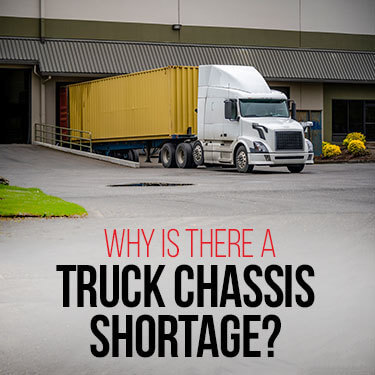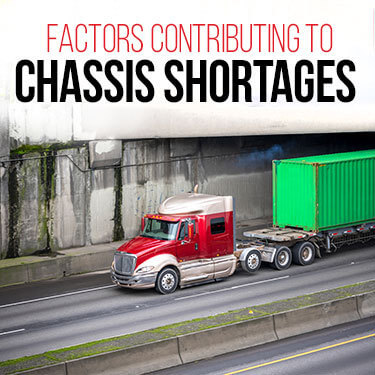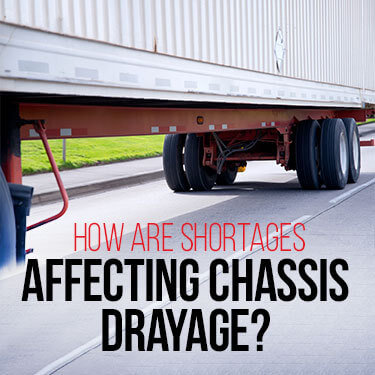A container chassis shortage impacts several areas of shipping and logistics. The availability of this simple metal frame affects everything from container availability to distribution schedules. Resolving this shortage has become a major concern for both trucking and marine shipping.
The National Highway Traffic Safety Administration (NHTSA) enforces federal safety regulations on all commercial trailers, including container chassis. Between increased use and a backlog in domestic production, fewer road-worthy chassis are available. This shortage is further hurt by poor management of container movements.
Discover the biggest influences of the truck chassis shortage and how businesses can navigate its effect on the supply chain.
Supply chain shortages and production delays have become somewhat normalized in our post-pandemic world. However, when it comes to a shortage of equipment vital for supply chain movement, things get a little tricker.
Planning for and managing the container chassis shortage isn’t the responsibility of any one group. The shortage has a different effect depending on where your business falls along the supply chain.
Groups most impacted by the shortage of chassis include:
Each of these groups has attempted to solve the chassis shortage issue in different ways. Despite these efforts, shortages are still a major problem that ends up affecting the consumer market at some point.
Without truck chassis to haul marine shipping containers on land, two major issues come up. First of all, without port chassis, containers coming off ships can’t move out of the port. Secondly, if drayage yards can’t get chassis, they are unable to return empty containers back to the port.
Full containers at port mean empty store shelves for customers. Empty containers in truck yards mean higher prices for customers. This is from carriers dealing with demurrage and detention fees from ports that want their containers back.
To understand the depth of the problem, we’ll go into detail about some of the practices and events that triggered it.

There is no single reason for the drastic container chassis shortage currently affecting the United States. For the most part, it’s just a bad combination of factors made worse by the effects of the Covid-19 pandemic.
Some of these factors include:
To be clear, the U.S. has always had a shortage of container chassis. Despite the nation’s position as a major importer and exporter, our ports are not known for their efficiency in handling containers when compared to European and Asian counterparts.
This is partially due to a lack of emphasis on drayage services, which didn’t become popular until recently. After major ports started experiencing record-setting delays, drayage became the preferred solution to ease some of the congestion.
However, carriers quickly realized that there just wasn’t enough chassis to go around. Quite suddenly, chassis shortages went from being a seasonal annoyance to a year-round headache.
With the rise of eCommerce during the pandemic, and its continued push, shipping activity simply hasn’t slowed enough to provide relief. Quite honestly, it isn’t likely to either which only increases the pressure on an already strained system.

We previously mentioned long-standing factors that mostly became problems after chassis demand increased. There have also been more recent developments that further contribute to the issue.
One of these is the rise in eCommerce, mentioned earlier. This has been good for the shipping industry as a whole, allowing companies to expand and hire more people. That said, it’s been a hard trend to keep up with.
Other recent factors include:
On their own, these factors may have been solvable. Together, and combined with the existing issues, solutions are harder to come by.
An ELD is an Electronic Logging Device provided for truck drivers to track their working hours and loads. The ELD Mandate is a congressional rule of 2016 that requires a specific level of technology to be used by commercial drivers with Hour-of-Service (HOS) limitations.
These drivers are required to submit a Record of Duty Status (RODS) to the Department of Transportation (DOT) to show they are remaining within legal limits. The implementation of the ELD mandate was meant to place driver safety first and ensure good working conditions.
With that said, there are drawbacks to the close monitoring of loads and hours. To avoid penalties and fees, limits on drivers are strictly enforced, which affects chassis and container movement.
Prior to the regulation, a driver may have been able to take on an extra load or two, even if just to return empty containers and chassis to the port from a drayage yard. With the extra monitoring, such movements simply aren’t possible.
Building or importing more chassis seems like a logical response to a shortage, but high steel tariffs make that difficult too.
Building new chassis requires steel and iron, which the U.S. imported large amounts of from China until a series of new tariffs in 2018 made it extremely expensive to do so. Referred to as Section 301 and Section 232 tariffs, these imposed up to a 25% tax on various products, including steel.
These tariffs also included various finished products, including whole chassis from China. This means importing the finished product becomes more expensive too.
Ultimately, there is a trickle-down effect of negative impacts.
At the end of the day, it doesn’t paint a very good picture for carriers desperately seeking ways to move containers. It actually encourages bad habits because some carriers and retailers will hold onto chassis longer than they should just to ensure they have one when needed.
The good news is that steel manufacturing is picking up more speed as the U.S. increases its metal imports from other countries such as Canada and Mexico. The progress may be slower than some prefer, but it is progress.
Depending on who you ask, you will hear that there is a surplus or a shortage of marine shipping containers. Depending on where you are, both scenarios are correct.
The U.S. has more issues with surplus containers, as do many countries that tend to import more than export. It’s always been a standard practice to send empty containers back on ships, but now they’re piling up faster than they’re being returned.
Because ports are individually managed, it’s not easy to find national numbers. However, we can get a basic look at this trend by examining some statistics out of the Port of Los Angeles and Long Beach, one of the busiest in the country.
| Month | Incoming Containers | Outgoing Containers | Remainder |
| January | 428,474 | 437,121 | -8,647 |
| February | 426,812 | 430,951 | -4,139 |
| March | 497,775 | 460,898 | +36,877 |
| April | 458,264 | 429,093 | +29,171 |
| May | 501,679 | 466,220 | +35,459 |
This is only a small slice of the data, from only one port, but it shows a worrying trend. At the start of 2022, more containers were leaving than arriving. The number included both loaded and empty containers.
By March, there was a large jump in imports that could not be matched in exports. The problem has since gotten worse. This isn’t happening only at Long Beach ports, but on the East Coast as well at ports like New York and Savannah.
With so many containers piling up, both full and empty, drayage yards simply have no place to return other empties and bring back chassis. Meanwhile, ports are charging demurrage fees for containers being left at port and more fees for chassis not being returned. It’s turned into quite a vicious cycle.
Improving container management would ease the problem. Major carriers and 3PLs are investing in software programs like Container Management Systems (CMS) and improving freight tracking technology in general. By tracking where delays occur, they hope to reduce them and keep containers and chassis freely circulating.
The simple answer here is to say that the container chassis shortage will continue until enough new chassis are manufactured and made available.
After all, a chassis is a fairly simple piece of equipment and has been standard logistics equipment for decades. Although the solution seems simple, the reality is not.
The new production of chassis is limited by:
Although tariffs are highest on steel imported from China, it’s still taxed when it comes from other nations too. Even when the small numbers of factories in the U.S. can get materials, there aren’t enough people entering the industry.
New chassis also don’t solve the existing issues and bad habits of some retailers who hang on to chassis longer than they should. In short, there are many things still to overcome.
In the meantime, there are some alternatives to moving shipping containers that don’t involve a chassis. Lowboy and step deck flatbed trailers have been used successfully to move shipping containers.
Although not an ideal solution, they provide a short-term alternative while production efforts increase.
The majority of chassis in North America are owned by Intermodal Equipment Providers (IEPs). These are essentially equipment leasing companies and they provide short and long-term leases to various ports, carriers, and 3PLs.
Some smaller IEPs have actually come together to form the North American Chassis Pool Cooperative (NACPC). All combined, they account for the grand majority of current chassis and have the most pull when it comes to newly manufactured units.
Motor carriers can and do own chassis, as do some ports, but this is an exception. Although, more have been trying to do so as a way to combat shortages. Chassis rental charges themselves depend on a number of factors.
There are four common chassis leasing and use models:
All of these models have their pros and cons, but no single way seems to be able to solve the current issues.
Government oversight also doesn’t help in this situation. While the NHTSA and by extension, the Federal Motor Carrier Safety Administration (FMCSA) regulate the quality of chassis, they have no other authority over their use.
This is one of the reasons the U.S. Government Accountability Office (GAO), conducted a study that looked more closely into chassis use practices.

The United States, along with Canada and Mexico, use flatbeds and dry van trailers for the majority of items shipped by truck. Therefore, chassis are rarely used for long-haul jobs. A chassis’ most common use is for drayage services.
Drayage providers focus on short-haul services between larger and more established transport modes. A shortage of chassis has a bad effect on either end of that spectrum.
Drayage links two important services together:
We’ll examine how the shortage has affected these areas and how the wider market is impacted.
Port congestion is an issue all on its own. Between lockdowns of various ports and unavailable workforces at different points throughout the pandemic, port logistics have seen more than their fair share of problems.
Increased drayage helped relieve some of the congestion at ports up until a certain point. To be fair, the blame isn’t solely on the container chassis shortage. Drayage providers have also been unhappy about the lack of oversight on containers themselves.
Shipping containers are mostly overseen by the Ocean Carrier Equipment Management Association (OCEMA). However, containers themselves are usually owned by shipping companies. Without clear regulation from either group, the status quo tends to remain.
This had led to a few major issues for chassis and drayage services at ports:
For drayage to work, there needs to be enough available chassis and drivers to continue ferrying containers back and forth. Without freedom of movement, drayage services also become a problem.
Carriers and 3PL services alike are left to battle it out at the start of the day for the few openings that become available. Then they have to hope that their return trip isn’t in vain and that the port will accept the empty container and maybe even have another full one that can be shipped out.
Drayage services are a vital part of intermodal shipping too. Aside from making transload possible, drayage connects ports to the vast network of rail lines that crisscross the United States.
Shipping containers can typically be loaded straight onto specialized rail platforms that serve the same function as a chassis. This means goods don’t need to get transferred from one type of container to another.
Most rail yards actually do have the equipment to get a container off of a chassis, so they are less likely to hold onto the in-demand equipment.
This efficiency is good, but working with the railroads comes with an additional set of chassis regulations from the Association of American Railroads (AAR). All chassis that are used around rail yards must meet or exceed AAR chassis trailer standards.
The AAR has the strictest chassis regulations in logistics, which are great for safety, but bad for a limited and aging chassis pool.
Strict regulations on chassis structure and integrity are difficult to meet under some of the circumstances we’ve already reviewed.
There is a small gap between the standards set by the FMCSA and those set by the AAR. Manufacturers know that trucking companies will be satisfied with the FMCSA standards and the IEPs who buy the majority of them know that as well.
While not unsafe, they will be rejected by rail yards and intermodal shipping services. Rejected containers mean the chassis is once again stuck and train cars are chugging away at less than capacity.
Who ultimately pays for it? The price hikes end up falling on everyday consumers who are still waiting for store shelves to be fully stocked.
If your business needs intermodal shipping services, the best way to avoid having your freight rejected at the rail yard is to work with reputable carriers and 3PLs. Going with the cheapest bid may cause you to lose out on value-added services and quality equipment.
Don’t let a container chassis shortage bring down the mood. USA Truckload Shipping, powered by R+L Global Logistics, has connected with over 22,000 partner carriers throughout North America.
We vet our carriers for quality service and equipment so that you don’t need to. We’ve worked hard to provide reliable port drayage services at major shipyards from California to New York. Trust your business needs to a company that’s been offering solutions for years.
Need more than just drayage? Complete an RFP online now and view our other available services:
If you need it moved, we have the connections to help you move it. Call us today at (866) 353-7178 or request a risk-free quote online today.
R+L Global Logistics
315 NE 14th St., Ocala, FL 34470